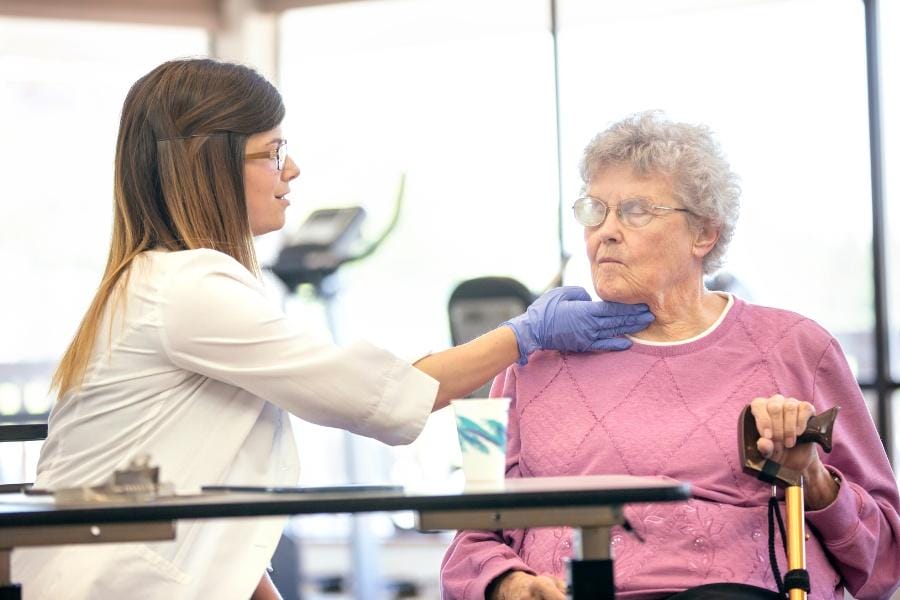Parkinson’s and Difficulty Swallowing: Managing Dysphagia
For people with Parkinson’s Disease, daily activities can become challenging.
One of the common issues faced is difficulty swallowing. Known as dysphagia, this condition can impact nutrition and overall health.
It is crucial to address swallowing problems early to prevent serious complications such as malnutrition or aspiration pneumonia.
The muscles involved in swallowing become weaker or less coordinated, leading to problems in swallowing food and liquids safely.
This can lead to coughing or choking during meals and may require special strategies or treatments to manage. Access to speech-language pathologists and programs can help improve communication and swallowing difficulties as Parkinson’s progresses.
Understanding the relationship between Parkinson’s and swallowing disorders is important for managing the disease effectively.
Different therapeutic approaches, including exercises, medications, or dietary adjustments, can make a significant difference. Learning more about these will empower patients and caregivers to handle these challenges with confidence.
Key Takeaways
- Early management of swallowing issues is crucial.
- Therapy and medication can improve swallowing.
- Support is available for better management.
How Parkinson’s Disease Affects People

Parkinson’s disease is a progressive disorder affecting movement and various body functions. It causes motor and non-motor symptoms, and often impacts swallowing abilities, complicating meal times and nutrition.
Motor and Non-Motor Symptoms of Parkinson’s Disease
Parkinson’s is not just a movement disorder. Motor symptoms are commonly known, including tremors, stiffness, and slowness of movement.
These symptoms make daily activities challenging. Individuals may have difficulty writing or using small instruments like utensils.
Non-motor symptoms, though less visible, are significant. They include sleep disturbances, depression, and speech changes.
These Parkinson’s symptoms can be more disabling and affect quality of life. They might not manifest together but develop as the disease progresses.
Implications for Swallowing Function
Swallowing difficulties typically emerge with other symptoms. The muscles involved in swallowing can be compromised due to Parkinson’s.
This leads to food or liquid being difficult or painful to swallow.
Choking hazards also increase, making meal times stressful. The risk of aspiration might lead to pneumonia.
Maintaining proper nutrition and hydration becomes vital. Professional assessments, like from speech therapists, help address these swallowing issues effectively.
Glossary: What is oropharyngeal dysphagia? Oropharyngeal or transfer dysphagia is defined by difficulty starting a swallow. Swallowing can be accompanied by nasopharyngeal regurgitation, aspiration, and a feeling of residual food remaining in the pharynx.
Progression of Parkinson’s and Swallowing Difficulties
As Parkinson’s advances, symptoms gradually worsen. Initially, swallowing problems might be mild, only occurring occasionally. Over time, they might become constant and more severe.
It’s important to adapt meal options and textures to ensure safe swallowing. Thicker liquids and softer foods might reduce choking risks.
Professional guidance from healthcare providers can help monitor and manage these difficulties throughout the progression of the disease. This proactive approach aids in maintaining a better quality of life for individuals with Parkinson’s.
Summary: Parkinson’s disease encompasses both motor symptoms like tremors and stiffness, and non-motor symptoms such as sleep disturbances and depression, all of which can significantly impact daily life and overall well-being. As the disease progresses, swallowing difficulties often emerge, compromising the muscles involved and increasing choking hazards, which necessitates adaptations in meal textures and professional guidance to ensure safe nutrition.
Swallowing Dysfunction in Parkinson’s

Swallowing dysfunction is a common issue faced by individuals with Parkinson’s disease, often impacting their ability to eat and drink safely. This can lead to health complications if not managed properly.
Mechanics of Swallowing Issues for PD Patients
In Parkinson’s, swallowing problems occur due to the slowed and reduced movement in the muscles responsible for chewing and swallowing.
These muscles in the mouth, throat, and chest are affected, leading to difficulties in controlling food and saliva. The loss of dopamine-producing neurons can cause these symptoms to worsen over time.
People with Parkinson’s may take longer to finish meals and find it hard to swallow pills. These challenges can also lead to increased drooling, which is a common symptom alongside swallowing issues.
Oral Dysfunction and Swallowing Challenges
Oral dysfunction in Parkinson’s affects the coordination of muscles used for chewing and moving food to the back of the throat.
This results in problems like difficulty in forming a proper bolus, the ball of chewed food that’s ready to be swallowed. Swallowing dysfunction, known as dysphagia, is a significant concern. People with Parkinson’s may struggle to recognize these changes in themselves due to impaired awareness and perception.
This can lead to further complications if not addressed. More information can be found through the American Parkinson Disease Association’s explanation of oral dysfunction.
Aspiration and Its Risks
Aspiration occurs when food or liquid goes down the wrong way, entering the lungs instead of the esophagus.
Unfortunately, this can lead to serious health complications, such as aspiration pneumonia. Aspiration may be silent, occurring without a cough, making detection and prevention crucial.
People with Parkinson’s are at a higher risk for these problems due to swallowing dysfunction.
They might experience weight loss, choking, or frequent lung infections. This highlights the need for careful monitoring and management of swallowing problems and risks of aspiration.
Swallowing Study and Assessment Methods
Swallowing evaluation is crucial for detecting difficulties in people with Parkinson’s. These tests often begin with clinical assessments focused on watching how a patient swallows various food and liquid consistencies.
Specialists may use swallowing-specific questionnaires to evaluate symptoms reported by patients and caregivers. In some cases, a clinical bedside swallow evaluation (CSE) is conducted to observe the swallowing process.
These initial assessments often guide whether further testing is needed. Sometimes, doctors use video X-rays to guess the extent of swallowing issues more precisely.
This approach improves diagnosis and informs the best treatment methods. Coordinated care from a multidisciplinary team is helpful as it brings together different specialists to tailor the evaluation and treatment for each patient.
Use of Barium Swallow Test
The barium swallow test is a vital tool in diagnosing swallowing problems. During the test, patients are asked to swallow a liquid containing barium, which appears on X-rays.
This allows doctors to see how the food or liquid moves through the throat and esophagus. This test helps identify blockages, irregular movements, or aspiration risks.
A variation of this test, known as the Modified Barium Swallow Test, focuses on assessing the oral and pharyngeal phases of swallowing.
It’s a key part of evaluating dysphagia in people with neurological disorders. The test provides a video of the swallowing process, offering a detailed view of the biomechanics involved. This helps in planning effective therapy strategies.
Fiberoptic Endoscopic Evaluation of Swallow (FEES)
FEES is another essential diagnostic approach for assessing dysphagia. This test involves using a small, flexible tube with a camera, inserted through the nose to visualize the throat while swallowing.
It allows for real-time observation of the swallowing process and identifies if any food or liquid is entering the airway (laryngeal penetration or aspiration).
Unlike the barium swallow test, FEES does not involve radiation exposure, making it a safer long-term monitoring tool.
This method provides clinicians with detailed insights into the pharyngeal stage of swallowing.
FEES is particularly useful in developing targeted interventions to improve swallowing safety and efficiency for Parkinson’s patients experiencing dysphagia.
Summary: Swallowing dysfunction, a common issue in Parkinson’s disease, affects muscles involved in chewing and swallowing, leading to difficulties in controlling food and saliva, increased risk of aspiration, and potential health complications. Various assessment methods, including clinical evaluations, barium swallow tests, and Fiberoptic Endoscopic Evaluation of Swallow (FEES), are crucial for diagnosing and managing these swallowing problems, enabling healthcare professionals to develop targeted interventions for improving swallowing safety and efficiency in Parkinson’s patients.
Management and Treatment of Swallowing Disorders

Dysphagia, or difficulty swallowing, is a common issue for individuals with Parkinson’s disease. Effective management involves a blend of therapies, exercises, and dietary adjustments tailored to improve swallowing function and safety.
Role of Speech-Language Pathologists
Speech-language pathologists (SLPs) are crucial in the evaluation and management of swallowing disorders.
They assess the extent of dysphagia using clinical evaluations and sometimes instrumental methods like a videofluoroscopic swallow study. Tailored treatment plans are developed based on these assessments.
SLPs often recommend therapies such as the Lee Silverman Voice Treatment (LSVT), which can improve vocal loudness and swallowing abilities.
Another role they have is educating patients about safe swallowing techniques and monitoring their progress.
Swallowing Exercises and Strategies
Swallowing exercises are designed to strengthen the muscles involved in swallowing.
These exercises can help improve control and reduce the risk of food or liquid entering the airway, which can lead to aspiration pneumonia. Examples include the Mendelsohn maneuver and the Shaker exercise.
Patients may be taught to tuck their chin while swallowing or take smaller bites to enhance safety. Consistent practice of these strategies can lead to significant improvements.
Nutritional Modifications and Food Texture Changes
Adjusting food textures plays a pivotal role in managing dysphagia. Foods may be softened, pureed, or thickened to make swallowing safer and easier.
This customization helps maintain nutritional intake while reducing the risk of choking.
Besides food texture, adjustments in meal planning, like having smaller and more frequent meals, are recommended to ensure adequate nutrition.
A dietitian may provide guidance on maintaining a balanced diet tailored to individual needs.
Lifestyle and Supportive Care Measures
People with Parkinson’s often face swallowing issues, which can lead to dehydration and malnutrition.
It is crucial to implement safe eating and drinking practices, enhance saliva control, and seek rehabilitation support to manage these challenges effectively.
Safe Eating and Drinking Practices with PD
Proper posture can significantly impact swallowing safety. Patients should sit upright during meals to reduce choking risks.
Keeping mealtimes calm by minimizing distractions is also essential for focusing on swallowing.
Hydration is key, so frequent sipping of water or other liquids is encouraged to combat dry mouth and dehydration. Eating smaller, more frequent meals can also help in managing swallowing difficulties.
A registered dietitian can offer tailored advice to ensure nutritional needs are met without compromising safety.
Enhancing Swallowing Safety and Saliva Control for Parkinson’s Patients
Saliva control can be challenging for individuals with Parkinson’s. Regular oral hygiene helps manage excess saliva and maintain mouth health. Using tools like adaptive utensils can further aid in safer swallowing.
Techniques such as closing lips tightly and tilting the chin slightly down when swallowing can prevent aspiration.
Adjusting food textures, like pureeing solid foods, might be necessary for safer ingestion. For those with severe issues, healthcare providers may consider options like tube feeding.
Support from Rehabilitation Therapies
Rehabilitation therapies play a vital role in managing swallowing problems. Speech and language therapists offer tutorials on exercises and techniques to improve swallowing function.
Programs like the Lee Silverman Voice Treatment and Expiratory Muscle Strength Training (EMST) enhance muscular function and respiratory support.
Therapists also help develop communication strategies to improve patient and caregiver interactions.
They offer tips for managing routine tasks, catering to each individual’s specific needs. Consistent follow-ups with rehabilitation specialists can ensure gradual improvements and better quality of life.
Get High-End Parkinson’s Disease Care
If you or a loved one suffers from Parkinson’s Disease, NurseRegistry can help. We offer in home nursing care by experienced professional RNs and LVNs/LPNs.
Beyond exceptional private nursing care, our friendly and dedicated team takes the time to diligently match you with a nurse that is compatible with you based on skill level, personality, age, and gender.
Get the best home care for Parkinson’s Disease today. Click below to learn more about NurseRegistry.
Frequently Asked Questions
Dysphagia can be a serious issue for those with Parkinson’s disease, affecting their ability to eat and drink safely. Understanding the symptoms and treatments can help manage and improve these conditions over time.
What treatments are available for dysphagia in Parkinson’s patients?
Treatments include professional therapy programs like the Lee Silverman Voice Treatment (LSVT) and SPEAK OUT! These programs are supported by evidence and focus on improving speech and swallowing. Patients can find specialized speech-language pathologists through the Parkinson’s Foundation Helpline.
What symptoms indicate the presence of dysphagia in those with Parkinson’s disease?
Symptoms of dysphagia may include coughing or choking while eating, difficulty swallowing, and food sticking in the throat. These symptoms can lead to nutritional deficiencies and require immediate attention from specialists to manage effectively.
How can speech and swallowing be affected by Parkinson’s disease?
Parkinson’s disease affects the muscles involved in speaking and swallowing. This occurs due to the loss of dopamine neurons, impacting motor control and leading to issues like slow or slurred speech. Swallowing difficulties are common and require specialized intervention.
Can swallowing exercises improve the condition of a Parkinson’s patient with dysphagia?
Swallowing exercises designed by speech-language pathologists can help strengthen the muscles involved in swallowing. By following a tailored exercise plan, patients may see improvements in their ability to swallow, decreasing the risk of choking and other complications.
What are common signs that Parkinson’s disease is progressing?
As Parkinson’s disease progresses, individuals may notice increased difficulty with balance, stiffness, and movement. Non-motor symptoms such as changes in mood, sleep disturbances, and cognitive changes can also become more pronounced as the disease advances.
What are the characteristics of the final stage of Parkinson’s disease?
In the final stage, Parkinson’s patients may experience severe mobility issues, requiring full assistance with daily activities. Communication can become difficult due to speech challenges, and managing symptoms may become more complex, often necessitating comprehensive care strategies.
The post Parkinson’s and Difficulty Swallowing: Managing Dysphagia appeared first on NurseRegistry.The post Parkinson’s and Difficulty Swallowing: Managing Dysphagia appeared first on NurseRegistry.
from NurseRegistry https://ift.tt/Wo5NYPt

Comments
Post a Comment